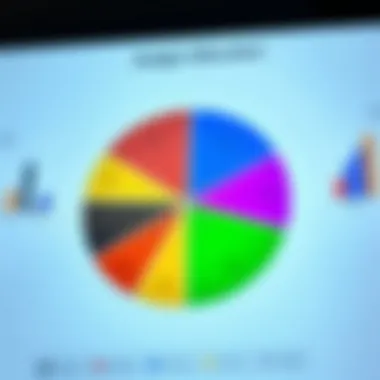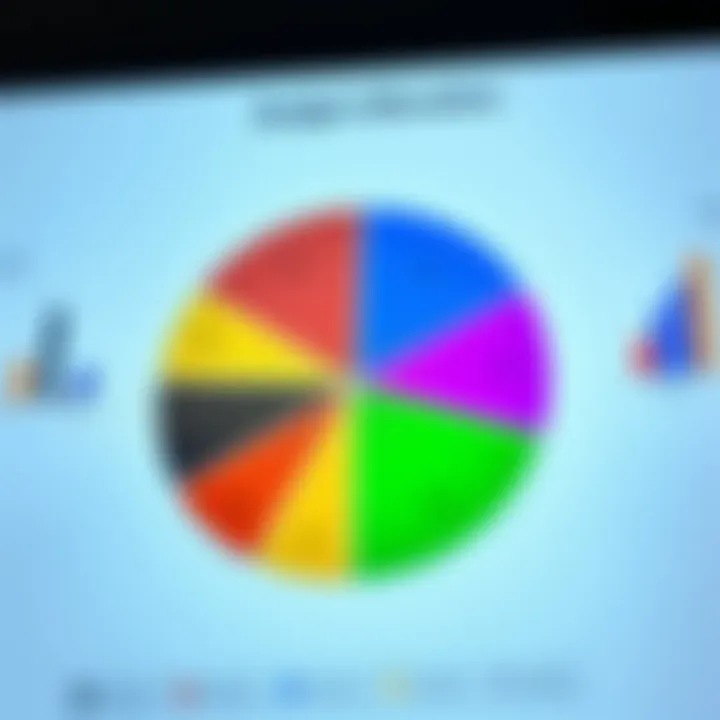The Downloadable Budget Planner: Enhance Your Finances


Intro
In today's fast-paced world, managing personal finances effectively can feel like trying to catch smoke with your bare hands. Many individuals find themselves grappling with overwhelming debts, unexpected expenses, or just a hazy view of their financial situation. This is where a downloadable budget planner steps in as a lifeline.
Here, we’ll explore how these planners not only simplify the budgeting process but also enhance financial literacy. By breaking down complex financial tasks into manageable components, a well-designed budget planner provides structure. It's like having a roadmap when you’re trying to navigate uncharted territory.
By the end of this examination, readers will gain essential insights into budgeting techniques, savings strategies, smart spending tips, investment insights, and long-term financial planning.
Let's dive into the practicalities of leveraging downloadable budget planners to enhance your financial health.
Understanding Budgeting
In any serious conversation about personal finance, understanding budgeting isn’t just a mere footnote; it’s a cornerstone. A budget works like a road map for your financial journey. Without one, you’re likely to get lost, driving in circles or, worse, heading directly to a financial dead end. By creating a solid budget, individuals can chart their income against their expenses, ensuring they’re living within their means while finding ways to save or invest for future goals.
The Concept of Budgeting
Budgeting, at its core, is the process of creating a plan for how to spend your money. This isn’t merely about knowing how much you earn versus how much you spend, but rather, it encompasses strategically allocating your resources. Think of it as meticulously divvying up a pie; each slice represents a different area of your financial life—be it rent, groceries, entertainment, or savings.
One could even go so far to say that budgeting is like hitting the refresh button on your financial health. It allows you to assess where you are, pinpoint areas that need improvement, and shift funds around as necessary. Consider how life is full of surprises; from unexpected expenses to sudden changes in income, an adaptable budget can keep you steady and aligned with your goals.
Importance of Financial Planning
Having a budget tightens the focus on financial planning. Imagine trying to build a house without blueprints; it could end up a chaotic mess that might crumble. Financial planning gives the structure and the budget lays the foundation. It aids in moving toward long-term objectives like buying a house, retirement, or even fun items like vacations.
The benefits of effective budgeting include, but are not limited to, developing conscientious spending habits, fostering discipline in financial matters, and building a safety net for unforeseen circumstances. Thus, if you truly wish to become financially literate, you must embrace budgeting as the avenue to not just know where your money goes, but also to understand your financial choices deeply.
"A budget is telling your money where to go instead of wondering where it went."
— John C. Maxwell
Ultimately, it’s imperative to understand that budgeting isn’t restrictive; it’s empowering. By opening up a conversation about your finances and integrating a structured plan, you're investing in your future. People who engage in budgeting are more likely to notice an improvement in their financial well-being, leading to less stress and fostered financial literacy.
What is a Downloadable Budget Planner?
In the age of digital transformation, a downloadable budget planner emerges as a notable asset for individuals aiming to sharpen their financial management skills. A downloadable budget planner is essentially a digital tool that enables users to organize and manage their income and expenses in a systematic way. This section will further explore the foundation and variations of these planners, emphasizing their importance in contemporary financial practices.
Definition and Overview
A downloadable budget planner can be defined as a digital format for tracking personal finances, which users can easily download, customize, and utilize. Unlike traditional pen-and-paper methods, these planners offer flexibility and efficiency through accessibility on devices such as computers, tablets, and smartphones. They often come equipped with pre-set formulas and categories, allowing users to input their financial data effortlessly. In this digital era, having such tools readily available not only simplifies budgeting but also fosters a proactive approach toward managing financial health.
Formats and Variations
The realm of downloadable budget planners includes several formats that cater to varying preferences and technical abilities. Each format holds unique characteristics and benefits that contribute to efficient budgeting.
Excel-based Planners
Excel-based planners are a popular choice due to their versatility and customizability. They allow for the incorporation of complex calculations, making them ideal for users needing more detailed financial analysis. The key characteristic of Excel planners lies in their grid-like structure, which grants users the ability to manipulate data conveniently.
One unique feature is the capacity to automate calculations for income and expenses, thus minimizing manual entries and potential errors.
However, they come with their own set of challenges, such as requiring a basic understanding of spreadsheet functions. Nonetheless, their adaptability to personal needs makes them a beneficial option for those looking to dive deeper into their financial landscape.
PDF Templates
PDF templates offer a straightforward, print-friendly format that many users find appealing. These templates are typically straightforward and user-friendly, promoting simplicity in budget tracking. The main advantage of PDF planners is that they can be filled out by hand, which resonates well with individuals who prefer tangible methods over digital screens.
Unique features include a visually structured layout with designated sections for various expense categories. While they are great for straightforward budgeting, the lack of interactive features means adjustments must be made on paper, which can limit flexibility in tracking expenses. Still, for the more traditional budgeters, they remain a reliable option.
Mobile Applications
Mobile applications have surged in popularity, thanks to their accessibility and user-centric design. These apps often come infused with additional features, such as alerts for overspending or reminders for bills, which enhance their functionality beyond mere budgeting. One of the standout characteristics of mobile apps is their ability to integrate directly with bank accounts, providing real-time insights into spending activities.
A unique feature of many mobile applications is their user interfaces, which are often designed with a gamification concept. This can motivate users to engage with their financial data in a more meaningful way. However, this also means that users must be comfortable sharing their financial information online, which can be a drawback for some. Despite this, mobile applications serve as a beneficial resource for many, especially on-the-go individuals.
Key Features of Effective Budget Planners
When it comes to managing finances, having a solid budget planner is essential. A budget planner doesn’t just help track your spending; it serves as a roadmap to financial health. Here, we explore the crucial features that make a budget planner effective and how these elements can greatly benefit users.
User-Friendly Interface
A user-friendly interface is one of the primary characteristics that separates a great budget planner from a mediocre one. When users dive into managing their money, the last thing they want is to wrestle with confusing layouts or convoluted navigation. A clean, intuitive design allows users to focus on the task at hand — budgeting.


Considerations for a User-Friendly Interface:
- Simplicity: Users should be able to enter their expenses and income with ease without scrambling through layers of menus.
- Visual Appeal: Graphs and charts can offer quick insights into spending habits. Seeing a pie chart for expenses might resonate better than a long list of numbers.
- Accessibility: Whether it's on a desktop or a mobile application, the planner should be accessible anytime, anywhere. This ensures that when inspiration strikes or a purchase is made, jotting it down is a breeze.
Categorization of Expenses
Next up is the categorization of expenses. This feature is vital because it enables users to distinguish between different spending areas. By categorizing expenses, individuals can evaluate where their money flows – and where it might be leaking.
How Categorization Helps:
- Trend Analysis: Recognizing spending patterns is crucial. Categorizing expenses allows users to see if they're splurging on dining out versus essentials like groceries.
- Budget Adjustment: With a clear view of expenses, users can reallocate funds from less essential categories to those that are higher priority, enhancing financial control.
- Goal-Oriented Budgeting: Users can tailor their categories based on specific goals like saving for a vacation or paying off debt, making the budgeting process more personalized and focused.
Goal Setting and Tracking
Lastly, effective budget planners should allow for goal setting and tracking. Setting financial goals gives users something to strive for, and tracking progress keeps motivation levels high.
The Benefits of Goal Setting and Tracking:
- Clarity and Purpose: Having defined goals, whether it's saving for a new car or cutting expenses to improve savings, adds a layer of clarity to budgeting efforts.
- Progress Monitoring: Many planners offer features to visually track progress towards financial goals. This can be motivating and lead to better spending decisions.
- Adjustment Capabilities: If a target isn’t being met, users can quickly adjust their finances. The ability to revisit and revise goals ensures that financial plans remain realistic and achievable over time.
"Without a clear target, you're just shooting in the dark."
In summary, the key features of effective budget planners revolve around user-friendliness, expense categorization, and goal tracking. These elements create a streamlined process that enhances financial literacy and equips individuals with the tools they need to manage their money more effectively. By investing time in selecting the right features, users position themselves for greater financial stability and success.
Benefits of Using a Downloadable Budget Planner
In the realm of personal finance, the significance of utilizing a downloadable budget planner cannot be overstated. This tool serves more than just a basic calculator for your income and expenses; it acts as a crucial ally in the battle against financial mismanagement. Among the myriad benefits, three stand out prominently: enhanced financial awareness, improved spending habits, and long-term financial stability.
Enhanced Financial Awareness
Using a downloadable budget planner goes a long way toward deepening your understanding of your financial circumstances. When you input your regular income and expenses, the planner provides a clear, visual representation of your financial life.
It's a bit like holding a mirror up to your finances. You see where your money is flowing, and in this process, patterns often emerge. For instance, you might discover that you spend more on dining out than you had originally thought. This realization can be a real eye-opener, one that prompts you to reconsider your choices.
Moreover, regularly updating your planner encourages you to keep tabs on not just your expenditure but also your savings and investments. Tracking these metrics helps to establish a healthier relationship with money. This awareness can provide a sense of control, leading to more informed decisions about future spending or saving strategies.
Improved Spending Habits
Another key advantage lies in the impact a budget planner can have on your spending habits. It encourages mindfulness about where your dollars are going.
When you categorize expenses—like groceries, utilities, and entertainment—each segment becomes a spotlight illuminating your consumer behavior. You may find that extravagant purchases never quite deliver the satisfaction you expected, or that cutting back on non-essentials can free up funds for investments or travel.
Not only does a budget planner help curb impulse buying, but it also fosters a culture of accountability. Each dollar has a purpose, and becoming aware of your habits leads to better choices. For instance, if you realize you often overspend on subscriptions, you can evaluate which services you're actually using and which could be canceled. As thoughts of financial freedom start germinating, conscious spending takes root.
Long-term Financial Stability
The long game of financial stability is perhaps the most compelling reason to embrace a downloadable budget planner. When individuals take charge of their finances in the short term, they set the groundwork for greater financial security in the long haul.
By continuously tracking expenses and revenue, you can not only meet immediate financial goals but also plan for future ones, like buying a house, paying off student loans, or saving for retirement.
As time goes on, consistent budgeting paves the road to substantial savings that can act as safety nets in emergencies or serve as investments for wealth growth. Over time, those small steps can compound, leading to significant savings.
For example, putting away even a modest sum each month can accumulate into a considerable nest egg with appropriate investment.
In a nutshell, a downloadable budget planner is more than a tool; it’s a step towards transforming your financial life. With improved awareness, refined spending habits, and a keen sense of stability, you’re not just surviving; you're thriving in the intricate dance of finance.
Challenges in Budgeting
Budgeting, while fundamentally an exercise in managing finances, comes with its share of challenges that can deter even the most dedicated individuals. Without a grasp of these hurdles, one may underestimate the seriousness of maintaining a balanced budget. Understanding the common pitfalls and the need to ensure data accuracy and updates are critical to navigating the budgeting landscape effectively.
The importance of addressing these challenges cannot be overstated. Engaging with budgeting strategies can significantly enhance financial awareness and lead to better spending habits. However, if one is not aware of the common pitfalls, achieving long-term financial stability may seem like trying to catch smoke with your bare hands. Thus, insight into these challenges is not merely beneficial; it’s essential for anyone serious about their financial future.
Common Pitfalls
Many people approach budgeting with good intentions but often find themselves falling into common traps that derail their efforts. Here are some typical pitfalls to be aware of:
- Underestimating Expenses: It’s easy to forget to include small but frequent expenses like coffee runs or lunch outings. These seemingly minor costs can add up quickly.
- Lack of Flexibility: Adhering too rigidly to a budget can lead to frustration, especially if unexpected expenses pop up. A budget that does not allow for adjustments can create tension and ultimately lead to abandonment of the budgeting process altogether.
- Ignoring Irregular Income: For those with income that fluctuates, using a static budget can be misleading. Not accounting for this variability may lead to overspending in leaner months.
- Failure to Review: Setting a budget is just the start; failing to regularly review and adjust it can render it useless. Life changes, and so should the budget.
Being aware of these pitfalls leads individuals to build more realistic and dynamic budgets, enhancing their chances of success in managing finances.
Data Accuracy and Updates
One of the most decisive factors in effective budgeting is the accuracy of the data inputted into the planner. Ignoring this can lead to a cascade of issues. Here’s why accurate data and frequent updates hold critical importance:
- Real-Time Insight: Accurate data provides a snapshot of current finances, enabling you to catch unwanted spending patterns before they spiral out of control.
- Informed Decisions: With up-to-date figures on hand, individuals are better positioned to make informed financial decisions, whether that involves reallocating funds or scaling back on discretionary spending.
- Setting Realistic Goals: When the information in your budget reflects true spending habits, setting achievable financial goals becomes simpler and more aligned with reality.
- Adjusting for Changes: Life is unpredictable. Having the ability to swiftly update your budget can help one adapt to changes—be it a job loss, a promotion, or unexpected medical expenses.


In summary, the challenges in budgeting can seem daunting at first, but by addressing common pitfalls and ensuring data accuracy, individuals pave the way toward a successful budgeting journey. Understanding these elements arms individuals with the awareness necessary to navigate the intricacies of personal finance effectively. This not only enhances their budgeting efforts but boosts their overall financial literacy.
Choosing the Right Budget Planner
Selecting the right downloadable budget planner stands as a pivotal step in managing personal finances effectively. With an array of options readily available, each with unique features and designs, understanding one’s specific requirements becomes the cornerstone of the planning process. Having a suitable planner not only helps in tracking expenses but also supports a person's broader financial goals. More so, by choosing the right tool, individuals are less likely to feel overwhelmed or lost in the budgeting journey.
Identifying Your Needs
Before diving into the various budget planners, it’s essential to take a step back and assess your needs. Consider various factors like your financial habits, goals, and lifestyle. Are you a meticulous planner who likes to monitor every little expense, or do you prefer a more laid-back approach focusing on overall spending limits? Identifying your primary motivations can significantly narrow down your options.
- Lifestyle factors: Think about how busy your days are. If you're constantly on the go, a mobile application may serve you better than a detailed spreadsheet.
- Financial goals: Are you saving for a specific target, such as a vacation or a new home? Look for planners that integrate goal-setting features.
- Accountability needs: Do you work better with detailed reports or simple overviews? Understanding your tracking preferences will help you select a planner that fits well into your routine.
Finding a planner that resonates with your needs makes a world of difference, negating the likelihood of frustration in the future.
Evaluating Features and Usability
Once you pinpoint your needs, it’s time to dive deep into features that different planners offer. The right features can turn a regular planner into a powerful ally in your financial journey. While there are numerous features to consider, focus on those that will enhance usability and directly contribute to your financial awareness.
- User-friendliness: Look for an intuitive design that allows you to navigate without getting lost in complex menus and options. A planner should make budgeting easier, not more convoluted.
- Customization Options: Some planners allow users to modify categories according to their needs. This flexibility is vital if your spending doesn't fit traditional molds.
- Integration Capabilities: Assess whether the planner can connect with your bank accounts or financial applications. Integration features lead to real-time data, minimizing the guesswork involved in tracking your spending.
- Visual Tools: Charts and graphs serve a dual purpose; they not only provide a clear overview of spending patterns but can also motivate users. Finding a planner that emphasizes visual representations can streamline decision-making processes.
"The right planner can be the difference between a chaotic financial life and one that’s organized and controlled."
This process might require some initial effort, but considering these aspects will set the stage for a smoother budgeting experience down the road.
How to Implement a Downloadable Budget Planner
Implementing a downloadable budget planner can seem like a daunting task if you’re not familiar with the lingo it often entails. Yet, it serves as a foundational stone in a solid financial structure. A budget planner is a tangible guide that helps you map your income against your expenses, ensuring you keep a tight rein on your finances. By effectively implementing one, you gain control over your spending, contribute to savings, and enrich your financial future.
Setting Up Your Planner
Setting up your budget planner is pivotal. This is not just about filling in numbers and hoping for the best; it’s about creating an environment that promotes financial awareness.
Start by gathering all relevant financial documents—pay stubs, bills, bank statements, and any supporting items like loan agreements. Make a list of your income sources. This might include salaries, freelance earnings, or any side hustle that brings in extra dough.
Next, outline your fixed expenses—those inevitable costs that don’t shift much from month to month—like rent or mortgage, utilities, insurance, and debt payments. Then move onto variable expenses: groceries, transportation, and entertainment. This is where you want to keep a realistic outlook; no need for wishful thinking. It helps to categorize spending into sections which can make adjustments simpler later.
Once you’ve compiled this information, inputting it into your chosen planner—be it an Excel spreadsheet, a PDF, or a mobile app—should be straightforward. If you've gone for a digital option, ensure it allows for easy updating whenever changes occur.
"A goal without a plan is just a wish." — Antoine de Saint-Exupéry
Establishing your budget planner sets the stage for a successful financial journey. Knowing where each penny goes can lead to better decision-making and more informed choices regarding saving and spending.
Regular Monitoring and Adjustment
After your planner is set up, don’t just close the door and dust your hands off. Regular monitoring is key to sustaining a healthy financial plan. You want to keep an eye on this evolving document as life continually throws curveballs your way. Adjustments allow you to respond to unforeseen challenges and opportunities.
Check your budget at least once a month. Look at how your actual spending holds up against your planned spending. Are there categories where you consistently overspend? You might find that dining out drains your wallet more than you initially predicted.
Based on this review, make necessary adjustments. It could mean cutting back on luxuries or perhaps finding ways to boost your income—like taking on freelance gigs or selling items lying around your home. The goal here is flexibility; a budget should grow and change just as your circumstances do.
Incorporate the use of technology to assist with monitoring. Many downloadable planners offer reminders and alerts when you approach your limits within certain categories. This keeps your financial habits in check and instills discipline.
Embedded in regular checks and adjustments is not just the tracking of numbers, but also the understanding of your financial behavior. Diving deep into your spending habits can expose patterns—both positive and negative. Over time, this insight builds awareness and paves the way to better money management.
Implementing a downloadable budget planner maintains a rhythm in your financial life. Thus, by setting it up soundly and continuously monitoring and adjusting it, you equip yourself to handle your financial future more effectively.
Real-Life Application of Budget Planners
When it comes to managing personal finances, real-life applications of budget planners cannot be overstated. These tools provide a structured approach to understanding and controlling one's finances, serving as a compass to navigate the often turbulent waters of financial obligations. The practicality of a downloadable budget planner unfolds in various aspects of life, ultimately steering individuals towards a more stable economic future.
One essential element of real-life application is spending discipline. Budget planners help users categorize expenditures, making it easier to see where the money drips away. For example, if someone continuously finds their paycheck diminishing before the month is out, a budget planner can provide clarity. Once the planner reveals that dining out or impulse shopping is a recurring theme, it prompts a user to rethink those habits, fostering more prudent financial choices.
Additionally, planners serve as a goal-setting mechanism. Individuals often wish to achieve specific financial milestones, such as buying a house, saving for a child's education, or preparing for retirement. Without a clear plan, these aspirations can often feel like pipe dreams. A budget planner showcases how much needs to be saved every month to make these goals achievable, giving users a sense of direction and urgency.
Benefits to Consider
- Awareness of Financial Health: Regularly using a budget planner cultivates an acute awareness of one's financial state, helping to identify both strengths and vulnerabilities.
- Customization: Depending on individual circumstances, many planners allow users to customize sections based on their needs — from tracking debts to measuring savings towards a vacation.
- Trend Analysis: With a downloadable planner, users can review past data to detect spending trends, improving future budgeting strategies.
Case Studies and Examples
To truly understand the value of budget planners, we can look at several case studies illustrating their impact:


- Alice's Journey to Debt Freedom: Alice used a budget planner to tackle her credit card debt. By diligently tracking her spending habits, she discovered significant monthly expenditures on subscriptions she didn’t even use. By eliminating those unnecessary costs and allocating the savings towards her debt payments, Alice was able to pay off her credit cards within a year.
- Tom and Sarah's Home Ownership: A young couple, Tom and Sarah, desired to buy their first home. Utilizing a budget planner, they laid out a realistic timeline and monthly savings goals. The planner helped them visualize their savings required for a down payment, ensuring that they didn’t miss out on opportunities in the housing market.
- Retirement Planning with David: David realized that retirement seemed distant and vague. With a budget planner that included retirement variables, he could comprehend his current status and what he’d need to secure a comfortable latter life. The planner enabled him to project future savings based on his current contributions and adjust his spending habits accordingly.
Each of these examples underscores a profound truth: budget planners are not mere sheets of numbers; they are tangible tools that translate intentions into actions, paving the way to financial independence.
"A goal without a plan is just a wish." - Antoine de Saint-Exupéry
In your own financial journey, consider how downloadable budget planners can transform abstract goals into tangible results.
Integrating Budgeting with Other Financial Tools
In our current financial landscape, merely tracking expenses isn't sufficient anymore. The act of budgeting has evolved into a comprehensive strategy, increasingly tied to various financial tools and apps available today. Understanding how to integrate budgeting with these tools can significantly enhance your financial management skills. This section will explore the vital aspects of merging your budget with other financial resources, illustrating the benefits and considerations involved in making these connections.
Linking Accounts and Banks
When it comes to managing finances, ease of access can’t be overlooked. Linking your bank accounts directly to your budget planner is like having a financial advisor at your fingertips. This integration offers several advantages:
- Real-Time Insights: With transactions feeding directly into your budget, you can maintain an up-to-the-minute awareness of your financial health.
- Streamlined Management: Instead of juggling multiple logins, you can view all your data in one place, making it simpler to assess spending and saving patterns.
- Automated Tracking: Many budget planners can automatically categorize expenses, saving you precious time and minimizing manual entry errors.
Consider this: if your bank account is live-linked, you’re less likely to overlook small purchases that can add up over time. Noting every coffee run or impulse buy can become a tedious task, but when connected seamlessly, these details come to light without added effort.
"Linking your accounts can transform budgeting into an effortless and intuitive process. It ensures that nothing slips through the cracks."
While linking accounts is highly beneficial, it’s essential to consider security. Make sure your budget planner utilizes encryption and follows strict security protocols to protect your financial data. Additionally, if unsure about transparency, check reviews or reach out to the support of your budgeting tool to ensure your information is handled responsibly.
Utilizing Financial Apps
Today’s digital ecosystem caters to a myriad of financial applications. These apps can greatly amplify how you handle your finances beyond basic budgeting. A few noteworthy integrations can include:
- Investment Tracking: Linking your budgeting tool with investment apps can offer clarity on your overall net worth, encompassing savings, expenses, and investments.
- Debt Management: Some apps provide features that focus on tracking debts and loan payments, enabling you to prioritize them within your overall budget.
- Savings Goals: Certain applications allow you to set and monitor specific savings targets, creating a guided approach to achieving financial milestones.
By using financial applications, you not only boost your budgeting efficiency, but you can also gain a broader perspective on your financial standing. There’s a range of choices, from all-in-one platforms to niche apps designed for specific needs, giving you the power to personalize your financial tracking experience.
When choosing financial apps to integrate with your budget planner, here are some pointers to keep in mind:
- Compatibility: Ensure the apps sync seamlessly with your budget planner; this interconnectivity can save significant time.
- User Reviews: Look for apps with positive feedback, especially regarding functionality and user experience.
- Integration Features: Some apps offer more than just basic tracking; evaluate which ones align best with your financial goals.
Leveraging these integrations can turn a tedious chore into a streamlined process, helping you focus on your long-term financial ambitions. Investing time to understand how they connect can vastly improve your financial literacy and management efficiency.
Future Trends in Budget Planning
As we journey deeper into the realm of personal finance, it’s essential to keep an eye on emerging trends that shape our budgeting strategies. The landscape of budgeting is not static; it evolves with advancements in technology and shifts in consumer behavior. Understanding these trends is crucial for anyone looking to enhance their financial literacy and effectively manage their money.
Technological Advancements
The role of technology in budgeting is undeniably profound. Gone are the days when paper and pencil were the primary tools for financial planning. Today, a myriad of applications and software are available, offering features that simplify the budgeting process. Here are a few pivotal technological advancements to consider:
- Cloud-Based Systems: These systems allow users to access their budgets anytime, anywhere. Imagine sitting in a coffee shop and checking your spending limits in real-time. That's the flexibility cloud technology affords.
- Integration with Banking Apps: Many budgeting tools now sync directly with banking institutions, enabling automatic updates on expenses as they happen. This feature provides a clearer and more accurate financial picture without the need for manual data entry.
- User-Centric Design: Budgeting tools today prioritize user experience. Features are designed for ease of use, allowing anyone, regardless of tech-savvy-ness, to manage their finances effectively. Users appreciate intuitive layouts and easily navigable interfaces.
These adaptations not only enhance user engagement but also empower individuals to take charge of their financial futures with confidence.
Artificial Intelligence in Budgeting
When it comes to budget planning, artificial intelligence (AI) has begun to play an increasingly significant role. Leveraging algorithms, AI can analyze spending patterns and provide insights that were previously challenging to obtain. Here’s how AI is shaping the future of budgeting:
- Predictive Analytics: Tools utilizing AI can forecast future spending based on historical data. This allows individuals to anticipate potential financial pitfalls before they arise. For instance, if you're splurging on dining out, AI can alert you when you're veering off your projected budget.
- Personalized Recommendations: AI personalizes financial advice tailored to individual habits. If someone consistently overspends on entertainment, the AI can suggest curbing that area or developing a specific budget for it.
- Automated Tracking: With machine learning capabilities, budgeting apps can automatically categorize expenses into predefined groups, reducing the tedious task of manual entry. Users can easily see where money is going without intricate paperwork or calculations.
"Embracing AI in budgeting might just be the simplest decision you make for your financial future."
As we look toward the future, integrating these advancements can lead to smarter budgeting habits and a deeper understanding of where and how we spend money. Staying informed about these trends is essential for those eager to master their finances and attain long-term stability.
Ending
The conclusion of an article often serves as the cherry on top of a layered cake, a final touch that ties everything together, and in this case of downloadable budget planners, it holds significant weight. This section reflects the importance of understanding the insights laid out earlier in the discussion, reinforcing the transformative potential these planners have on personal finance.
Summarizing Key Insights
To summarize, the previous sections illuminated the critical aspects of using a downloadable budget planner. We explored varied types—from basic PDF templates to complex mobile applications—that cater to needs of different individuals. Each format offers unique features that can enhance financial awareness, help manage spending habits, and even encourage long-term goals. Planners are not merely sheets filled with numbers; they are tools designed to facilitate a better understanding of one’s financial landscape. Keeping track of expenditures by categorizing them can empower users to identify wasteful spending, and ultimately save more.
Final Thoughts on Budget Planning
Overall, adopting a structured approach to budgeting cannot be emphasized enough. A downloadable budget planner stands out as a practical solution for both the financially savvy and those just starting their journey into financial literacy. While budgeting may seem overwhelming at first, breaking it up into manageable tasks can ease the process significantly. Regularly updating and refining your planner encourages responsible financial behavior.
Ultimately, it’s not just about knowing where your money goes, but also about making informed decisions on how you want to allocate it for your future.
In closing, embracing a downloadable budget planner can pave the way toward financial freedom. It's the little things—like tracking an unexpected coffee expense or planning for that family vacation—that lead to larger victories. So, whether you're purchasing your first planner or looking to refine your existing process, remember the core aim of budgeting: to enhance your life's quality through informed financial choices.







